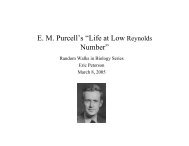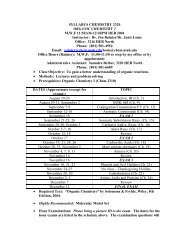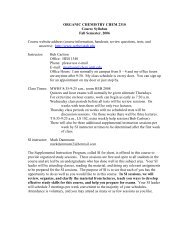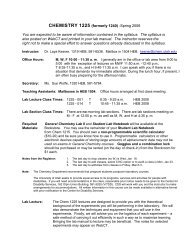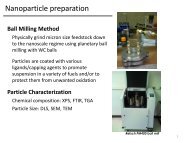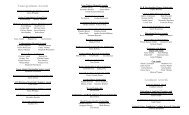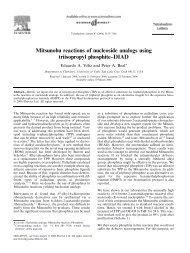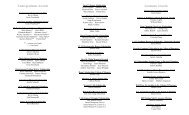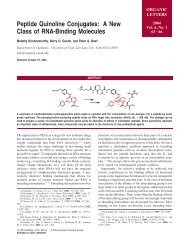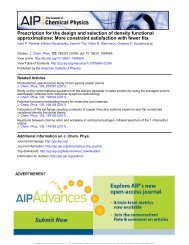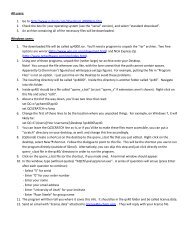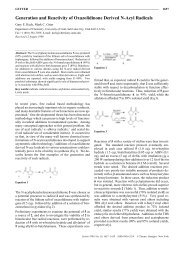Stereoselective synthesis of the C1–C13 segment of dolabelide B
Stereoselective synthesis of the C1–C13 segment of dolabelide B
Stereoselective synthesis of the C1–C13 segment of dolabelide B
You also want an ePaper? Increase the reach of your titles
YUMPU automatically turns print PDFs into web optimized ePapers that Google loves.
Tetrahedron<br />
Letters<br />
Tetrahedron Letters 46 (2005) 4911–4914<br />
<strong>Stereoselective</strong> <strong>syn<strong>the</strong>sis</strong> <strong>of</strong> <strong>the</strong> C 1 –C 13 <strong>segment</strong> <strong>of</strong> <strong>dolabelide</strong> B<br />
Gary E. Keck * and Mark D. McLaws<br />
Department <strong>of</strong> Chemistry, University <strong>of</strong> Utah, 315 South 1400 East, RM 2020, Salt Lake City, UT 84112-0850, USA<br />
Received 31 January 2005; revised 28 April 2005; accepted 28 April 2005<br />
Available online 4 June 2005<br />
Abstract—The efficient construction <strong>of</strong> <strong>the</strong> C 1 –C 13 <strong>segment</strong> <strong>of</strong> <strong>dolabelide</strong> B is described. A key element <strong>of</strong> <strong>the</strong> <strong>syn<strong>the</strong>sis</strong> entails BITIP<br />
catalyzed asymmetric methallylation to establish <strong>the</strong> C 7 stereocenter, which was <strong>the</strong>n used to direct <strong>the</strong> stereoselective installation <strong>of</strong><br />
<strong>the</strong> C 9 and C 11 centers through Evans reduction and 1,5-anti aldol condensation, respectively.<br />
Ó 2005 Elsevier Ltd. All rights reserved.<br />
The marine natural product <strong>dolabelide</strong> B is a member <strong>of</strong><br />
a small family <strong>of</strong> macrolides isolated from <strong>the</strong> sea hare<br />
Dolabella auricularia, which has been shown to exhibit<br />
cytotoxicity against HeLaS 3 cell lines with an IC 50 value<br />
<strong>of</strong> 1.3 lg/mL. 1 The biological activity <strong>of</strong> <strong>dolabelide</strong> B<br />
and its limited availability from natural sources have<br />
prompted a number <strong>of</strong> recent syn<strong>the</strong>tic studies directed<br />
toward this structure. 2–4 Herein, we report a concise<br />
stereoselective <strong>syn<strong>the</strong>sis</strong> <strong>of</strong> <strong>the</strong> C 1 –C 13 <strong>segment</strong> <strong>of</strong><br />
<strong>dolabelide</strong> B.<br />
We envisioned <strong>the</strong> <strong>dolabelide</strong>s as potentially being derived<br />
from <strong>the</strong> union <strong>of</strong> two subunits, 1 and 2 (Scheme<br />
1), arising from bond disconnection at <strong>the</strong> macrolactone<br />
and about <strong>the</strong> C 14 –C 15 olefin. Disconnection about <strong>the</strong><br />
C 14 –C 15 double bond to give Suzuki coupling precursors<br />
5 can be viewed taking place on ei<strong>the</strong>r side <strong>of</strong> <strong>the</strong> olefin,<br />
and both approaches were investigated during <strong>the</strong><br />
course <strong>of</strong> our study. However, as <strong>the</strong> <strong>syn<strong>the</strong>sis</strong> progressed,<br />
continued evaluation <strong>of</strong> our approach lead us<br />
to ultimately choose disconnection across <strong>the</strong> C 13 –C 14<br />
bond (disconnection a) as <strong>the</strong> most prudent course.<br />
Our past experience in syn<strong>the</strong>sizing skipped triol structures<br />
like that found in subunit 1 suggested that <strong>the</strong> desired<br />
stereochemical relationship could be constructed<br />
from aldehydes 3 and 5 through a sequence <strong>of</strong> asymmetric<br />
allylation using a 2-substitued allylstannane reagent,<br />
11<br />
OAc OAc<br />
OH<br />
15<br />
Me<br />
OH O<br />
a b<br />
Me<br />
Dolabelide B<br />
+<br />
R H<br />
3a R=CH=CH 2<br />
b R=<br />
OH<br />
Me<br />
Me<br />
Scheme 1. Retrosyn<strong>the</strong>tic analysis <strong>of</strong> <strong>dolabelide</strong> B.<br />
7<br />
O<br />
O<br />
OH Me OAc<br />
O<br />
SnBu 3 +<br />
H<br />
4 5<br />
Me<br />
R<br />
OTBS<br />
Me<br />
OAc OAc<br />
OP<br />
OBn<br />
R'<br />
1<br />
OP<br />
Me<br />
Me O<br />
HO<br />
OP OH OP Me OAc<br />
2 Me<br />
I<br />
a R=BR 2 ,R'=<br />
Me<br />
b R= I, R'=BR 2<br />
Me<br />
Keywords: Dolabelide; Asymmetric <strong>syn<strong>the</strong>sis</strong>; Allylation; Hydr<strong>of</strong>ormylation.<br />
* Corresponding author. Tel.: +1 801 581 7055; e-mail: keck@chem.utah.edu<br />
Present address: Albany Molecular Research Inc., Albany, NY 12212, USA.<br />
0040-4039/$ - see front matter Ó 2005 Elsevier Ltd. All rights reserved.<br />
doi:10.1016/j.tetlet.2005.04.146
4912 G. E. Keck, M. D. McLaws / Tetrahedron Letters 46 (2005) 4911–4914<br />
aldol reaction with 1,5-induction, and 1,3-reduction. 6 A<br />
process by which <strong>the</strong> initial hydroxyl group is introduced<br />
with a high degree <strong>of</strong> stereoselection is vital, given<br />
that this stereocenter will be used to control <strong>the</strong> stereochemistry<br />
<strong>of</strong> <strong>the</strong> remaining stereocenters <strong>of</strong> <strong>the</strong> triol <strong>segment</strong>.<br />
We have found <strong>the</strong> catalytic asymmetric allylation<br />
(CAA) reaction using <strong>the</strong> catalyst prepared from BI-<br />
NOL and titanium isopropoxide (BITIP) to be ideally<br />
suited for establishing remote secondary hydroxyl<br />
groups in a highly stereoselective fashion. 7–9 We were<br />
hopeful, <strong>the</strong>refore, that <strong>the</strong> CAA reaction would fulfill<br />
this requirement in <strong>the</strong> present instance.<br />
OH<br />
Me<br />
7<br />
Me<br />
OBn<br />
Rh(CO) 2 (acac)<br />
P(OPh) 3 , CO/H 2<br />
82% (96:4 5/9)<br />
Scheme 3. Hydr<strong>of</strong>ormylation <strong>of</strong> 7.<br />
OHC<br />
OTBS<br />
Me<br />
Me<br />
5 OBn<br />
+<br />
Me OTBS<br />
Me<br />
OHC<br />
Me<br />
9 OBn<br />
BnO<br />
EtO 2 C<br />
CHO<br />
a<br />
OH<br />
Me<br />
Me<br />
6 7<br />
Me<br />
8<br />
OTBS<br />
Me<br />
OBn<br />
e, f, g OHC<br />
Me<br />
OBn<br />
Me<br />
5<br />
b, c, d<br />
OTBS<br />
Me<br />
OBn<br />
Scheme 2. Reagents and conditions: (a) (Z)-crotyltributyltin, TiCl 4 ,<br />
90 °C, 2.5 h, 80% (15:1 dr); (b) TBSOTf, Et 3 N, CH 2 Cl 2 , 30 to 0 °C,<br />
1 h, 83%; (c) O 3 , CH 2 Cl 2 , 78 °C, 15 min; PPh 3 , rt, 2 h; (d)<br />
(C 6 H 5 ) 3 P = CHCO 2 C 2 H 5 ,CH 2 Cl 2 , rt, 18 h; (e) SmI 2 , MeOH, DMA,<br />
0 °C, 15 min, 55% (three steps); (f) DIBAL, THF, 78 °C, 4 h; (g)<br />
(COCl) 2 , DMSO, Et 3 N, 78 °C, 4 h, 83% (two steps).<br />
Our approach commenced with <strong>the</strong> <strong>syn<strong>the</strong>sis</strong> <strong>of</strong> aldehyde<br />
5 as shown in Scheme 2. The stereochemical relationship<br />
<strong>of</strong> <strong>the</strong> triad found in this <strong>segment</strong> lends itself<br />
well to <strong>syn<strong>the</strong>sis</strong> via crotylstannylation chemistry previously<br />
developed in our laboratories. 10 Thus, treatment<br />
<strong>of</strong> aldehyde 6 with TiCl 4 and (Z)-crotyl tributyltin provided<br />
7 in good yield and diastereoselectivity. After protection<br />
<strong>of</strong> <strong>the</strong> hydroxyl group, <strong>the</strong> backbone was<br />
extended by one carbon through a series <strong>of</strong> transformations<br />
involving oxidative cleavage <strong>of</strong> <strong>the</strong> terminal olefin<br />
followed by two-carbon homologation and net reduction<br />
11 to arrive at aldehyde 5. Although this sequence<br />
was successful at producing <strong>the</strong> desired aldehyde in an<br />
overall yield <strong>of</strong> 30% from 6, <strong>the</strong> overall process was<br />
far more cumbersome and lengthy than we desired. Indeed,<br />
we recognized that overall this six step sequence<br />
was equivalent to a reductive carbonylation <strong>of</strong> olefin 7.<br />
Therefore, a more direct approach involving hydr<strong>of</strong>ormylation<br />
was investigated in order to streamline <strong>the</strong><br />
production <strong>of</strong> intermediate 5. Hydr<strong>of</strong>ormylation <strong>of</strong> terminal<br />
olefins is a powerful reaction type; however, it<br />
most commonly results in mixtures <strong>of</strong> linear and<br />
branched regioisomers. A thorough search <strong>of</strong> <strong>the</strong> literature<br />
suggested that, in this instance, hydr<strong>of</strong>ormylation<br />
<strong>of</strong> olefin 7 might be expected to proceed with some degree<br />
<strong>of</strong> regioselectivity to favor <strong>the</strong> linear product due<br />
to <strong>the</strong> steric environment defined by <strong>the</strong> methyl substituent<br />
at C 4 . 12 Indeed, in <strong>the</strong> event, <strong>the</strong> reaction proved<br />
exceptionally regioselective giving a linear/branched<br />
ratio <strong>of</strong> 96:4 in favor <strong>of</strong> <strong>the</strong> desired product, which<br />
was isolated by chromatography in 82% yield (Scheme<br />
3). This three-step sequence (crotyl addition, silyation,<br />
and hydr<strong>of</strong>ormylation) was easily scaled to furnish multigram<br />
quantities <strong>of</strong> aldehyde 5 from compound 6 in an<br />
overall yield <strong>of</strong> 54% and as a single isomer.<br />
The <strong>syn<strong>the</strong>sis</strong> <strong>of</strong> <strong>the</strong> triol portion <strong>of</strong> subunit 1 can be approached<br />
from ei<strong>the</strong>r <strong>of</strong> <strong>the</strong> two directions in which <strong>the</strong><br />
stereochemistry <strong>of</strong> <strong>the</strong> hydroxyl bearing carbon at ei<strong>the</strong>r<br />
<strong>the</strong> C 7 or C 11 stereocenters is set through asymmetric<br />
methallylation. While an approach that first establishes<br />
<strong>the</strong> C 11 hydroxyl group would be considered more convergent,<br />
experimentation revealed that <strong>the</strong> subsequent<br />
aldol reaction between methyl ketone 10 and aldehyde<br />
5 required a three-fold excess <strong>of</strong> 5 to achieve acceptable<br />
conversion (Scheme 4). Therefore, a more linear approach<br />
was taken to minimize consumption <strong>of</strong> such an<br />
advanced intermediate, as shown in Scheme 5. BITIP<br />
catalyzed methallylation <strong>of</strong> 5 gave alcohol 12 in 96%<br />
yield and with 94:6 diastereoselectivity. After protection<br />
<strong>of</strong> <strong>the</strong> resulting hydroxyl group as <strong>the</strong> PMB e<strong>the</strong>r, <strong>the</strong><br />
methylene group was oxidatively cleaved to give <strong>the</strong> aldol<br />
precursor 13. Aldol condensation <strong>of</strong> ketone 13 with<br />
aldehyde 3b using conditions developed by Paterson<br />
et al. 13 afforded <strong>the</strong> desired 1,5 anti product with a pleasing<br />
90:10 diastereomeric ratio, but in a disappointing<br />
30% yield. The meager yield was attributed to decomposition<br />
<strong>of</strong> aldehyde 3b during <strong>the</strong> reaction, and a significant<br />
improvement was achieved by using <strong>the</strong> more<br />
robust aldehyde 14. Likewise, condensation with acrolein<br />
was successful and afforded <strong>the</strong> desired 1,5-diol in<br />
83% yield and as a single isomer (Scheme 6). The resulting<br />
alcohol 17 was protected as <strong>the</strong> silyl e<strong>the</strong>r and <strong>the</strong><br />
PMB group was removed with DDQ to unmask <strong>the</strong><br />
directing group for anti reduction. Reduction <strong>of</strong> <strong>the</strong> b-<br />
hydroxy ketone with SmI 2 /methanol 14 occurred essentially<br />
quantitatively, however <strong>the</strong> diastereomeric ratio<br />
was only 2:1 in favor <strong>of</strong> <strong>the</strong> desired anti product. We<br />
O<br />
OPMB<br />
10<br />
O<br />
OPMB<br />
+<br />
OH<br />
11<br />
OHC<br />
Me<br />
Me<br />
5<br />
OTBS<br />
Me<br />
OBn<br />
OTBS<br />
Me<br />
OBn<br />
(C 6 H 11 ) 2 BCl, Et 3 N,<br />
Et 2 O, -78 °C<br />
93%, 92:8 dr<br />
Scheme 4. C 7 –C 8 bond construction via 1,5-anti aldol condensation.
G. E. Keck, M. D. McLaws / Tetrahedron Letters 46 (2005) 4911–4914 4913<br />
OHC<br />
O<br />
d<br />
5<br />
Me<br />
OPMB<br />
13<br />
OTBS<br />
Me<br />
OH<br />
12<br />
OBn<br />
Me<br />
SnBu<br />
a<br />
+ 3<br />
OTBS<br />
Me<br />
OTBS<br />
Me<br />
+<br />
Me<br />
OBn<br />
O<br />
OH<br />
R<br />
OBn<br />
b, c<br />
have found, 15–17 as have o<strong>the</strong>rs, 18,19 that <strong>the</strong> syn/anti ratio<br />
obtained from b-directed reduction <strong>of</strong> ketones with<br />
SmI 2 can be greatly influenced by a number <strong>of</strong> factors,<br />
including <strong>the</strong> nature <strong>of</strong> <strong>the</strong> neighboring functionality,<br />
solvent, additives, and proton source. In many cases,<br />
<strong>the</strong> diastereoselectivity can be increased, or even<br />
switched, by attenuating one or more <strong>of</strong> <strong>the</strong>se factors.<br />
Unfortunately, all attempts to improve <strong>the</strong> syn/anti<br />
selectivity <strong>of</strong> this particular SmI 2 mediated reduction<br />
failed. Improved selectivity was ultimately achieved<br />
using tetramethylammonium triacetoxyborohydride 20 to<br />
4<br />
R<br />
OPMB<br />
3b R=H<br />
14 R=TMS<br />
Me<br />
OTBS<br />
Me<br />
OBn<br />
CHO<br />
15 R=H,30%(90:10dr)<br />
16 R = TMS, 95% (91:9 dr)<br />
Scheme 5. Reagents and conditions: (a) (R)-(+)-1,1 0 -bi-2-naphthol,<br />
Ti(OiPr) 4 ,4ÅMS, CH 2 Cl 2 , 20 °C, 5 days, 96% (94:6 dr); (b) NaH, p-<br />
methoxybenzyl bromide, KI, THF, 0 °C, 6 h, 91%; (c) OsO 4 ,NMO,t-<br />
BuOH/THF/H 2 O, rt, 1.5 h; NaIO 4 , rt, 2 h, 89%; (d) (C 6 H 11 ) 2 BCl,<br />
Et 3 N, Et 2 O, 78 to 20 °C, 22 h.<br />
O<br />
b, c<br />
OPMB<br />
13<br />
OAc OAc<br />
OTBS<br />
Me<br />
19<br />
OTBS<br />
Me<br />
O<br />
OBn<br />
OTBS<br />
Me<br />
OH<br />
a<br />
18<br />
OTBS<br />
Me<br />
OBn<br />
Me<br />
O<br />
OPMB<br />
OH 17<br />
OTBS<br />
Me<br />
OBn<br />
Me<br />
d, e<br />
OTBS<br />
Me<br />
OBn<br />
Scheme 6. Reagents and conditions: (a) acrolein, (C 6 H 11 ) 2 BCl, Et 3 N,<br />
Et 2 O, 78 to 20 °C, 22 h, 83% (single isomer); (b) TBSOTF, 2,6-<br />
lutidine, THF, 0 °C, 1 h, 96%; (c) DDQ, 10:1 CH 2 Cl 2 /pH 7 buffer,<br />
0 °C, 40 min, 89%; (d) Me 4 NBH(OAc) 3 , 1:1 acetonitrile/AcOH,<br />
15 °C, 5 h, 85%; (e) Ac 2 O, DMAP, pyridine, rt, 18 h, 94%.<br />
give <strong>the</strong> diol as a 26:1 (anti/syn) mixture that was separable<br />
by chromatography, <strong>the</strong>reby affording <strong>the</strong> desired<br />
isomer in 85% yield. Completion <strong>of</strong> <strong>the</strong> <strong>syn<strong>the</strong>sis</strong> <strong>of</strong> this<br />
<strong>segment</strong> was accomplished uneventfully by acetylation<br />
<strong>of</strong> <strong>the</strong> resulting diol, providing 19 with all stereocenters<br />
in place, in a total <strong>of</strong> 11 linear steps with an overall yield<br />
<strong>of</strong> 24% from compound 5. 21,22 Future events leading to<br />
subunit coupling will require <strong>the</strong> removal <strong>of</strong> <strong>the</strong> benzyl<br />
protecting group found at C 1 , and oxidation <strong>of</strong> <strong>the</strong> alcohol<br />
to <strong>the</strong> acid. Hydroboration <strong>of</strong> <strong>the</strong> olefin at C 12 –C 13<br />
with 9-BBN is expected to provide <strong>the</strong> appropriate Suzuki<br />
coupling partner for ring closure.<br />
Acknowledgements<br />
Financial assistance provided by <strong>the</strong> National Institutes<br />
<strong>of</strong> Health (through Grant GM-28961) and by Pfizer,<br />
Inc., is gratefully acknowledged.<br />
References and notes<br />
1. Ojika, M.; Nagoya, T.; Yamada, K. Tetrahedron Lett.<br />
1995, 36, 7491–7494.<br />
2. Grimaud, L.; de Mesmay, R.; Prunet, J. Org. Lett. 2002, 4,<br />
419–421.<br />
3. Desroy, N.; Le Roux, R.; Phansavath, P.; Chiummiento,<br />
L.; Bonini, C.; Genêt, J.-P. Tetrahedron Lett. 2003, 44,<br />
1763–1766.<br />
4. Schmidt, D. R.; Park, P. K.; Leighton, J. L. Org. Lett.<br />
2003, 5, 3535–3537.<br />
5. Miyaura, N.; Suzuki, A. Chem. Rev. 1995, 95, 2457–2483.<br />
6. Keck, G. E.; Wager, C. A.; Wager, T. T.; Savin, K. A.;<br />
Covel, J. A.; McLaws, M. D.; Krishnamurthy, D.; Cee, V.<br />
J. Angew. Chem., Int. Ed. 2001, 40, 231–234.<br />
7. Keck, G. E.; Tarbet, K. H.; Geraci, L. S. J. Am. Chem.<br />
Soc. 1993, 115, 8467–8468.<br />
8. Keck, G. E.; Krishnamurthy, D. Syn. Prep. 1998, 12–18.<br />
9. Keck, G. E.; Krishnamurthy, D.; Grier, M. C. J. Org.<br />
Chem. 1993, 58, 6871–6874.<br />
10. Keck, G. E.; Savin, K. A.; Cressman, E. N. K.; Abbott,<br />
D. E. J. Org. Chem. 1994, 59, 7889–7896.<br />
11. Inanaga, J.; Sakai, S.; Handa, Y.; Yamaguchi, M.;<br />
Yokoyama, Y. Chem. Lett. 1991, 2117–2118.<br />
12. Ojima, I.; Tsai, C.-Y.; Tzamarioudaki, M.; Bonafoux, D.<br />
Org. React. 2000, 56, 1–354.<br />
13. Paterson, I.; Gibson, K. R.; Oballa, R. M. Tetrahedron<br />
Lett. 1996, 37, 8585–8588.<br />
14. Keck, G. E.; Wager, C. A.; Sell, T.; Wager, T. T. J. Org.<br />
Chem. 1999, 64, 2172–2173.<br />
15. Keck, G. E.; Wager, C. A. Org. Lett. 2000, 2, 2307–2309.<br />
16. Keck, G. E.; Knutson, C. E.; Wiles, S. A. Org. Lett. 2001,<br />
3, 707–710.<br />
17. Keck, G. E.; Truong, A. P. Org. Lett. 2002, 4, 3131–3134.<br />
18. Chopade, P. R.; Davis, T. A.; Prasad, E.; Flowers, R. A.,<br />
II. Org. Lett. 2004, 6, 2685–2688.<br />
19. Davis, T. A.; Chopade, P. R.; Himersson, G.; Flowers, R.<br />
A., II. Org. Lett. 2005, 7, 119–122.<br />
20. Evans, D. A.; Champman, K. T.; Carreira, E. M. J. Am.<br />
Chem. Soc. 1988, 110, 3560–3578.<br />
21. The absolute stereochemistry <strong>of</strong> <strong>the</strong> triol <strong>segment</strong> was<br />
confirmed by a NMR spectral analysis <strong>of</strong> <strong>the</strong> C 7 Mosher<br />
esters and <strong>the</strong> C 7 –C 9 and C 9 –C 11 acetonides. See: Dale, J.<br />
A.; Mosher, H. S. J. Am. Chem. Soc. 1973, 95, 512–519;<br />
Rychnovsky, S. D.; Rogers, B.; Yang, G. J. Org. Chem.<br />
1993, 58, 3511–3515.
4914 G. E. Keck, M. D. McLaws / Tetrahedron Letters 46 (2005) 4911–4914<br />
22. All new compounds were characterized by IR, 1 H NMR,<br />
13 C NMR, and mass data. Spectroscopic and physical<br />
characterization data <strong>of</strong> selected compounds: Compound<br />
5: R f = 0.40 (15% EtOAc/hexanes); ½aŠ 20<br />
D<br />
+10.2 (c 0.95,<br />
CHCl 3 ); 300 MHz 1 H NMR (CDCl 3 ) d 9.74 (t, J = 1.8 Hz,<br />
1H), 7.35–7.26 (m, 5H), 4.49 (ABq, J AB = 11.9 Hz,<br />
Dv = 14.4 Hz, 2H), 3.59–3.46 (m, 2H), 3.30 (dd, J = 8.9,<br />
7.4 Hz, 1H), 2.55–2.30 (m, 2H), 2.04–1.89 (m, 1H), 1.78–<br />
1.42 (m, 3H), 0.97 (d, J = 6.9 Hz, 3H), 0.89 (s, 9H), 0.87<br />
(d, J = 6.9 Hz, 3H), 0.04 (s, 6H); 75 MHz 13 C NMR<br />
(CDCl 3 ) d 202.6, 138.7, 128.3, 127.5, 127.4, 76.9, 73.0,<br />
72.9, 42.3, 37.9, 35.9, 26.8, 26.1, 18.4, 15.0, 14.1, 3.8,<br />
4.1; IR (neat) 2931, 1726, 1458, 1254, 1097, 1057, 774,<br />
698 cm 1 . Anal. Calcd for C 22 H 38 O 3 Si requires C, 69.79;<br />
H, 10.12. Found: C, 69.52; H, 10.27. Compound 7:<br />
R f = 0.60 (35% EtOAc/hexanes); ½aŠ 20<br />
D<br />
0.8 (c 1.09,<br />
CHCl 3 ); 300 MHz 1 H NMR (CDCl 3 ) d 7.37–7.26 (m,<br />
5H), 5.91–5.79 (m, 1H), 5.06–5.03 (m, 1H), 5.00 (dd,<br />
J = 1.1, 1.1 Hz, 1H), 4.51, (s, 2H), 3.66 (dd, J = 9.1,<br />
4.3 Hz, 1H), 3.49 (dd, J = 9.1, 6.2 Hz, 1H), 3.40 (ddd,<br />
J = 6.9, 4.8, 4.8 Hz, 1H), 3.23–3.21 (m, 1H), 2.37–2.27 (m,<br />
1H), 2.00–1.85 (m, 1H), 1.04 (d, J = 6.7 Hz, 3H), 0.96 (d,<br />
J = 7.0, 3H); 75 MHz 13 C NMR (CDCl 3 ) d 142.2, 137.7,<br />
128.4, 127.7, 127.6, 114.0, 78.8, 74.7, 73.5, 40.9, 35.6, 14.4,<br />
13.2; IR (neat) 3487 (broad), 2965, 1455, 1092, 737,<br />
698 cm 1 . Anal. Calcd for C 15 H 22 O 2 requires C, 76.88; H,<br />
9.46. Found: C, 76.66; H, 9.56. Compound 12: R f = 0.26<br />
(5% EtOAc/hexanes); ½aŠ 20<br />
D +8.0 (c 1.28, CHCl 3); 300 MHz<br />
1 H NMR (CDCl 3 ) d 7.35–7.25 (m, 5H), 4.90–4.80 (m, 2H),<br />
4.40 (ABq, J AB = 11.9 Hz, Dv = 9.9 Hz, 2H), 3.72–3.62 (m,<br />
1H), 3.56 (dd, J = 8.9, 4.5 Hz, 1H), 3.51 (dd, J = 5.9,<br />
2.1 Hz, 1H), 3.29 (dd, J = 8.2, 8.2 Hz, 1H), 2.24–1.91 (m,<br />
3H), 1.76 (s, 3H), 1.72 (br s, 1H), 1.62–1.37 (m, 4H), 1.24–<br />
1.10 (m, 1H), 0.98 (d, J = 6.9 Hz, 3H), 0.89–0.87 (m, 12H),<br />
0.05 (s, 3H), 0.03 (s, 3H); 75 MHz 13 C NMR (CDCl 3 ) d<br />
142.8, 138.8, 128.3, 127.5, 127.4, 113.5, 77.5, 73.1, 72.9,<br />
68.9, 46.1, 37.9, 36.5, 35.4, 30.7, 26.1, 22.4, 18.4, 15.2, 14.3,<br />
3.7, 4.1; IR (neat) 3456 (broad), 2931, 1456, 1254,<br />
1097, 836, 773 cm 1 . Anal. Calcd for C 26 H 46 O 3 Si requires<br />
C, 71.83; H, 10.67. Found: C, 72.10; H, 10.65. Compound<br />
17: R f = 0.38 (25% EtOAc/hexanes); ½aŠ 20<br />
D<br />
+22.5 (c 1.63,<br />
CHCl 3 ); 300 MHz 1 H NMR (CDCl 3 ) d 7.34–7.19 (m, 7H),<br />
6.85 (d, J = 8.5 Hz, 2H), 5.82 (ddd, J = 16.0, 10.5, 5.5 Hz,<br />
1H), 5.25 (app dt, J = 17.2, 1.4 Hz, 1H), 5.12 (app dt,<br />
J = 10.5, 1.4 Hz, 1H), 4.57–4.35 (m, 5H), 3.90–3.84 (m,<br />
1H), 3.78 (s, 3H), 3.53 (dd, J = 9.16, 4.7 Hz, 1H), 3.48 (dd,<br />
J = 6.1, 2.7 Hz, 1H), 3.28, (dd, J = 8.7, 7.6 Hz, 1H), 3.10<br />
(br d, J = 3.8 Hz, 1H), 2.76–2.42 (m, 4H), 1.99–1.88 (m,<br />
1H), 1.60–1.35 (m, 4H), 1.25–1.08 (m, 1H), 0.96 (d,<br />
J = 6.9 Hz, 3H), 0.88 (s, 9H), 0.85 (d, J = 6.9 Hz, 3H), 0.02<br />
(s, 6H); 75 MHz 13 C NMR (CDCl 3 ) d 210.2, 159.2, 138.9,<br />
138.7, 130.3, 129.4, 128.3, 127.5, 127.4, 114.9, 113.7, 77.2,<br />
75.5, 73.0, 72.9, 71.3, 68.5, 55.2, 50.1, 48.4, 37.8, 36.6, 32.4,<br />
29.9, 26.1, 18.4, 15.3, 14.3, 3.7, 4.1; IR (neat) 3453<br />
(broad), 2931, 1710, 1514, 1250, 1093, 1038, 836,<br />
757 cm 1 . Anal. Calcd for C 36 H 56 O 6 Si requires C, 70.55;<br />
H, 9.21. Found: C, 70.36; H, 9.28. Compound 19:<br />
R f = 0.64 (25% EtOAc/hexanes); ½aŠ 20<br />
D<br />
+7.9 (c 0.1.54,<br />
CHCl 3 ); 300 MHz 1 H NMR (CDCl 3 ) d 7.34–7.25 (m,<br />
5H), 5.82 (ddd, J = 16.9, 10.4, 6.1 Hz, 1H), 5.17 (app. dt,<br />
J = 17.1, 1.4 Hz, 1H), 5.08–4.99 (m, 2H), 4.94–4.86 (m,<br />
1H), 4.48 (ABq, J AB = 12.1 Hz, Dv = 9.1 Hz, 2H), 4.13<br />
(ddd, J = 6.1, 6.1, 6.1 Hz, 1H), 3.52 (dd, J = 9.0, 4.6 Hz,<br />
1H), 3.47 (dd, J = 6.4, 2.6 Hz, 1H), 3.28 (dd, J = 9.0,<br />
7.6 Hz, 1H), 2.00 (s, 3H), 1.99 (s, 3H), 1.95–1.32 (m, 9H),<br />
1.20–1.08 (m, 1H), 0.95 (d, J = 7.0 Hz, 3H), 0.90 (s, 9H),<br />
0.87 (s, 9H), 0.83 (d, J = 6.7 Hz, 3H), 0.06 (s, 3H), 0.03 (s,<br />
3H), 0.02 (s, 3H), 0.01 (s, 3H); 75 MHz 13 C NMR (CDCl 3 )<br />
d 170.6, 170.3, 140.5, 138.7, 128.3, 127.4, 114.4, 77.1, 73.1,<br />
73.0, 70.7, 70.1, 67.3, 43.2, 38.8, 37.9, 36.3, 33.0, 30.1, 26.1,<br />
25.8, 21.1, 18.4, 18.2, 15.2, 14.0, 3.7, 4.1, 4.4, 4.9;<br />
IR (neat) 2931, 1741, 1470, 1363, 1249, 1095, 1027, 837,<br />
775 cm 1 . Anal. Calcd for C 38 H 68 O 7 Si 2 requires C, 65.85;<br />
H, 9.89. Found: C, 65.80; H, 9.92.



